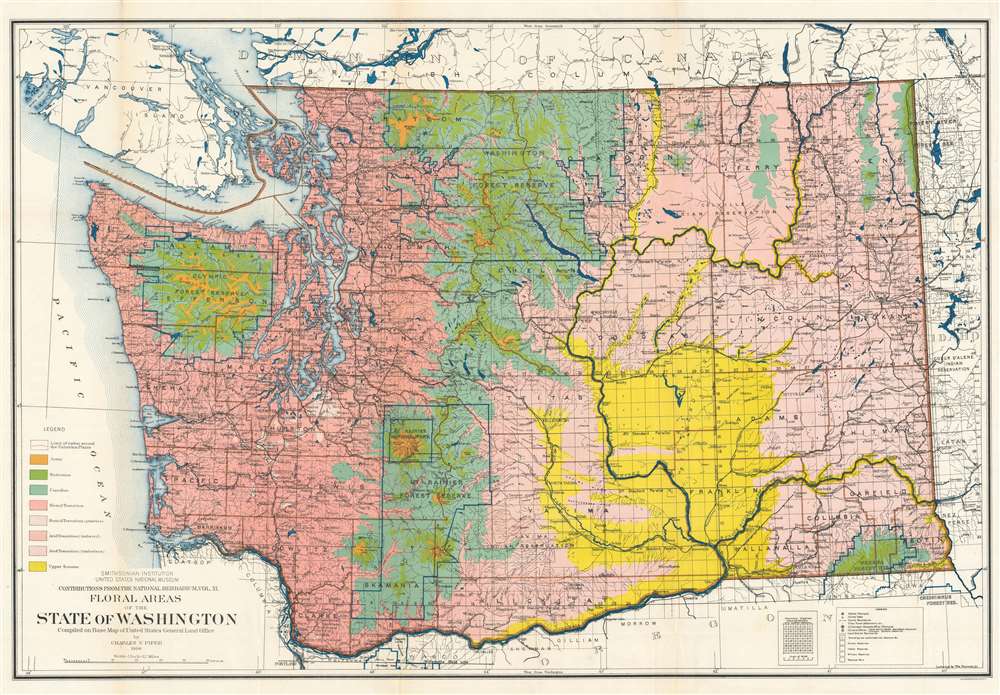1906 Piper Map of Washington State Floral Areas
WashingtonFloral-piper-1906
Title
1906 (dated) 24 x 34.75 in (60.96 x 88.265 cm) 1 : 760320
Description
Publication History and Census
This map was created by Charles V. Piper and printed by Julius Bien for publication by the Smithsonian Institution as part of Piper's book Flora of the State of Washington in 1906. The OCLC catalogues the map as being part of the institutional collections at Harvard, Laval University in Quebec, Miami (OH) University, the University of Chicago, the University of Wisconsin-Milwaukee, the University of Illinois Urbana-Champaign, Utah State University, Central Washington University, and the University of Washington but it is rarely seen on the private market. Piper's book, Flora of the State of Washington, is well represented institutionally, but is scarce on the private market.CartographerS
Charles Vancouver Piper (June 16, 1867 - February 11, 1926) was an American agriculturalist and Botanist. Piper was born in Victoria, British Columbia, Canada, and grew up in Seattle in the Washington Territory. In 1885 he graduated from the University of Washington and in 1892 taught botany and zoology at the Washington Agricultural College (now Washington State University). In 1900, Piper earned a master's degree in botany from Harvard University. Piper began working for the U.S. Department of Agriculture in 1903, where he concentrated on the domestication and introduction of grasses. On a trip to Africa, Piper found Sudan grass and introduced the grass into North America as a forage grass. He was also a noted expert in the flora of the northwestern United States and published several works on the subject, including Flora of the State of Washington in 1906, Flora of Southeast Washington and Adjacent Idaho in 1914 and Flora of the Northwest Coast in 1915. Piper was a founding member of the American Society of Agronomy in 1907 and eventually served as its president. Piper also studied soybeans, and published a book with William J. Morse entitled The Soybean in 1923, that is now considered a classic monograph on the species. Piper also served as Chairman of the More by this mapmaker...
Julius (Julien) Bien (September 27, 1826 - December 21, 1909) was a German-Jewish lithographer and engraver based in New York City. Bien was born in Naumburg, Germany. He was educated at the Academy of Fine Arts, Cassell and at Städel's Institute, Frankfurt-am-Main. Following the suppression of the anti-autocratic German Revolutions of 1848, Bien, who participated in the pan-German movement, found himself out of favor in his home country and joined the mass German immigration to the United States. Bien can be found in New York as early as 1849. He established the New York Lithographing, Engraving & Printing Company in New York that focused on the emergent chromo-lithograph process - a method of printing color using lithographic plates. His work drew the attention of the U.S. Government Printing Office which contracted him to produce countless government maps and surveys, including the Pacific Railroad Surveys, the census, numerous coast surveys, and various maps relating to the American Civil War. Bien also issued several atlases both privately and in conjunction with a relation, Joseph Bien. At the height of his career Bien was elected president of the American Lithographers Association. After his death in 1909, Bien's firm was taken over by his son who promptly ran it into insolvency. The firm was sold to Sheldon Franklin, who, as part of the deal, retained the right to publish under the Julius Bien imprint. In addition to his work as a printer, Bien was active in the New York German Jewish community. He was director of the New York Hebrew Technical Institute, the New York Hebrew Orphan Asylum, and president of the B'nai B'rith Order. Learn More...

